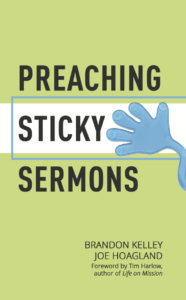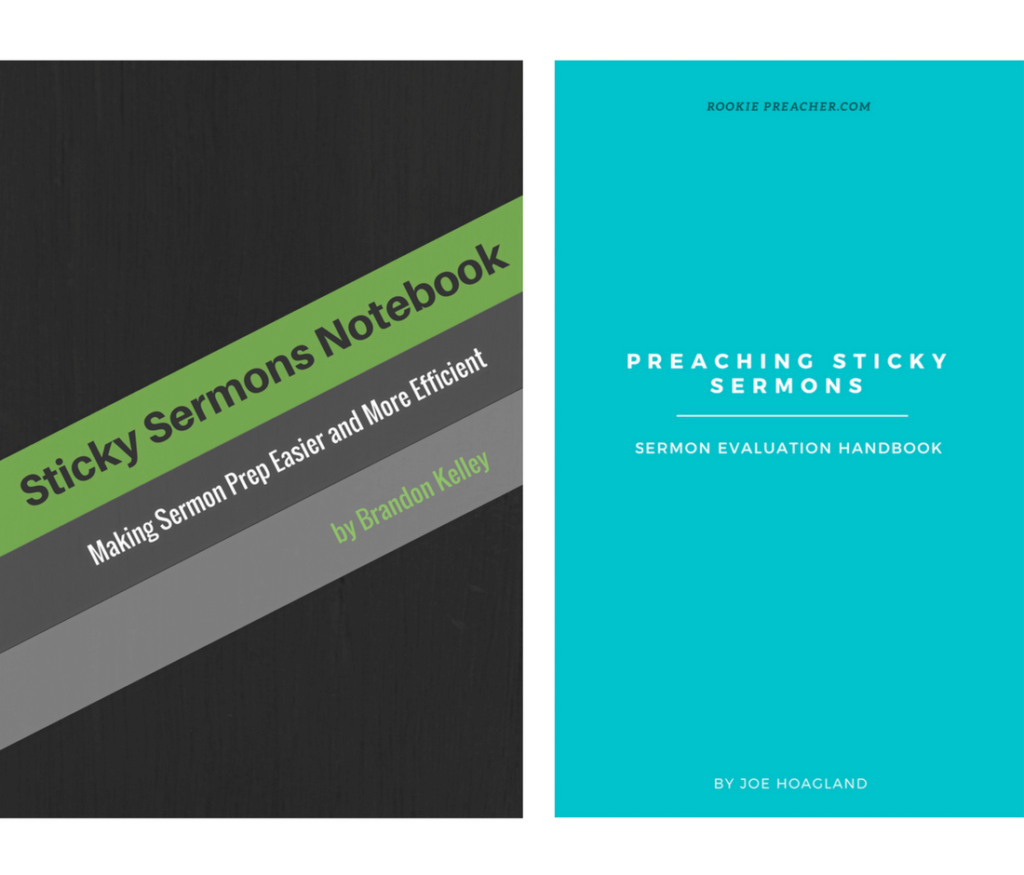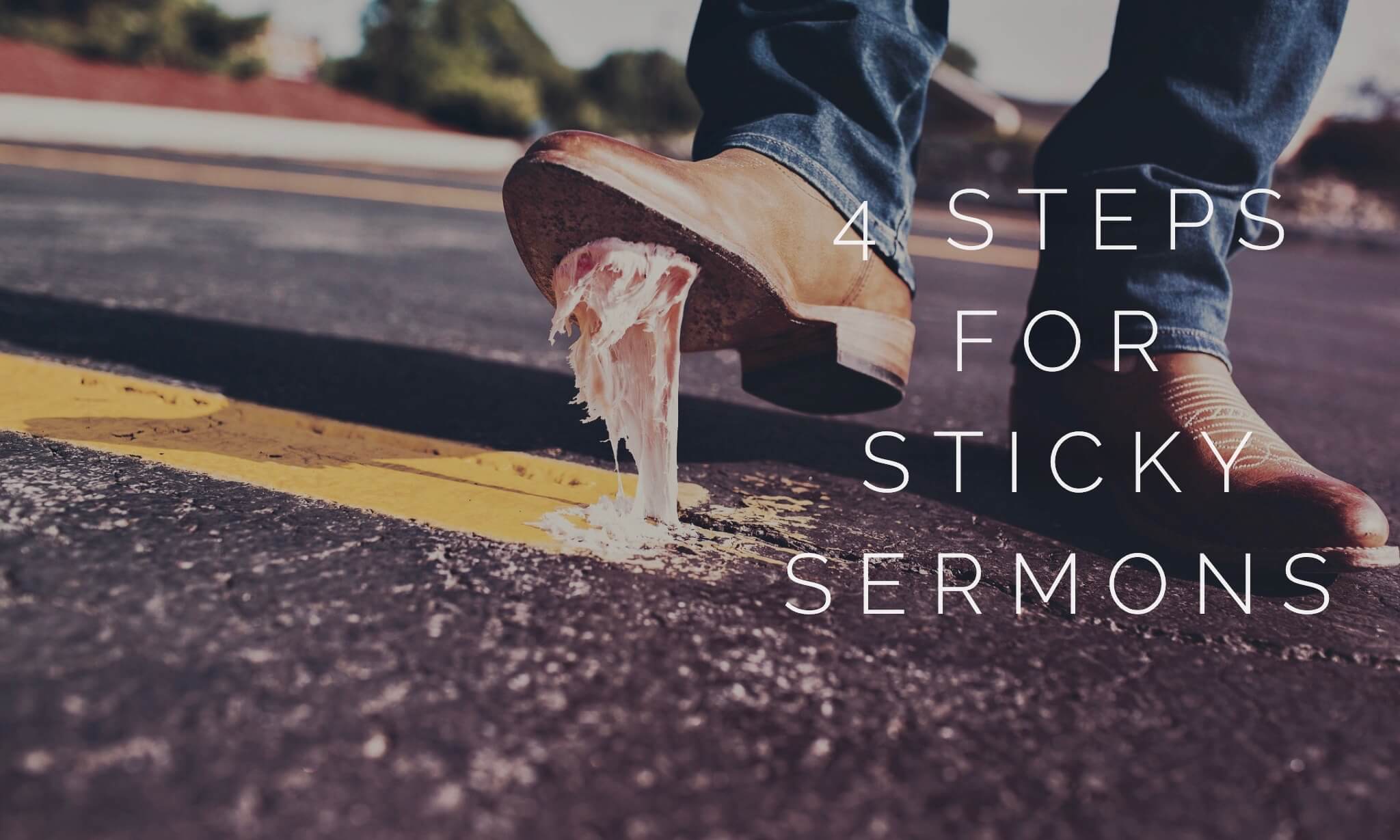4 Steps For Sermons That Stick Past Sunday
The following is a guest post by Brandon Kelley. Brandon Kelley is the co-founder of RookiePreacher.com, co-author of Preaching Sticky Sermons, and one of the pastors at The Crossing. Connect with him on Twitter @BrandonKelley_.
You knocked it out of the park, pastor! You’ve heard it. I’ve heard it. But I wonder how many of our sermons have stuck with our people past Sunday afternoon. It’s one thing to preach a message that resonates with people in the moment, but it’s another thing to preach a message that sticks with people well past Sunday and into the following week. But is there really a recipe of sermons that stick past Sunday? I think so.
Just imagine for a moment the stories that could be told from people in your church if they took action on Monday because of what they experienced on Sunday. Think about the story of the skeptic who is attending your church with their spouse who, week after week, are having their skepticism chipped away at because your sermons weren’t forgettable – they were memorable.
What would it look like if the community your church is embedded in encountered church people being the Church on Thursday and not just Sunday? It would be a beautiful thing.
To be sure, I’m not at all discounting God’s work in the process. Not at all. We have our part to do and we should do it as well as we possibly can. But in the end, it’s completely up to God what He does with our hard work and intentionality.
Step 1: Resolve to Make Your Sermon Point to One Big Idea
Brandon (not me, your fearless leader here at Pro Preacher) has a great article entitled, How to Preach One Big Idea Without Forcing It that you should read if you haven’t already. Make your sermon simple to remember. One big idea has the power to stick with people for years to come.
Here are a couple examples of big ideas from some recent sermons of mine:
- Our response to Jesus – Mighty God – must be to join the chorus of creation and give Him praise.
- The peace of God’s world replaces the panic of ours.
- Drive everything toward your one big idea.
This is vital for step 4. More on that soon.
Step 2: A Sermon Structure That Inspires and Calls to Action
The foundation of a sermon that sticks past Sunday is the sermon structure. If you structure your sermon in a way that engages people’s interests, hooks them with real-life tension, clearly teaches God’s truth, shows real-world application, inspires people toward a new future, and calls them to a single, specific action, you’ll have a sermon that sticks.
Most pastors do a good job at having a hook in the beginning of their message, clearly teaching God’s truth, and then giving application. But most messages miss two vital parts: inspiration and a call to action.
There’s a difference between helping people apply the text and painting a picture of what could be if they did apply the text. In the same way, there’s a difference between applying the text and calling people to take a specific action.
Let’s break these two down:
Inspiration
After you have taken the time explain the truth of the biblical text and apply it to today, begin helping people see the potential results of having the biblical truth be their present and future reality.
Two powerful, yet simple ways to do this are (1) use if this… then imagine… statements, and (2) ask what would it look like if… questions.
To inspire people, we must not simply tell them something, we must help them see something.
- If you and your spouse were to prioritize prayer in your lives – together – starting today, imagine what your marriage would look like a year from now.
- What would your legacy be if you were to simply begin reading Scripture as a family at the dinner table? Can you imagine the impact this could have in the lives of your children – and you?
You get the idea. The key here is to get their mind engaged in imagining a future with God’s truth embedded in it in an even greater way than it is presently.
Action
This is where the rubber meets the road. What are you calling people to do? Make this specific.
Give your life to Jesus. Join a small group. Pray this prayer this week. Read your Bible daily for one week.
Choose one thing. Two if you have a call to action for those who aren’t followers of Christ yet and one for those who are. But no more than that.
I’m sure you’ve heard this before but it’s important to repeat: don’t let anyone leave thinking, so what?
Step 3: Sermon-Based or Theme-Based Small Groups
Just picture all the people who are a part of small groups in your church wrestling with the application and call to action from the Sunday sermon. They’ll hold each other accountable to taking action and, in turn, make the sermon stick even more. This is the picture you’ll get if you choose to implement sermon-based small groups.
Another option is to have the small group curriculum address the same theme as the Sunday sermon. Instead of directly addressing the same text or same big idea, it will come at it from a different angle. This can be extremely effective as it will broaden the possibilities of application and action.
For more on sermon-based small groups, check out these articles:
- The Good and Bad of Sermon-Based Small Groups
- Seven Advantages of Sermon-Based Small Groups
- How to Create a Sermon-Based Small Group Study
Step 4: Leverage Social Media and Email
If you have resolved to do step 1, this step will be easy to implement.
This step will work great no matter if your church is on Facebook only or it is on other platforms like Twitter, Instagram, and YouTube, just to name a few.
Our biggest social media channel is by far Facebook, followed by Instagram, and then Twitter. Every week, we have a strategy for our social media that points people back to the big idea of the Sunday sermon.
Create a Social Media Graphic for the Big Idea
Here’s an example of what that can look like:
We usually post this on Monday or Tuesday. A great tool to use to create these is Canva.com. We grab free photos that do not need to be credited from two main sites: Unsplash.com and Pixabay.com.
Create a Short Video Clip of a Key Part of the Sermon
We call this #CrossingRewind (our church name is The Crossing). Here’s an example of a past one:
We post this on Thursdays. A good practice is to add some background music at a 5% – 10% volume level to help set the tone for the clip. We use Soundstripe for the background music. I highly recommend it.
Include the Full Sermon Link and Short Video Clip in Your Weekly Email
Every Thursday we send out an email to our congregation. Toward the bottom is a link to both the full sermon and the short video clip.
For more ideas on how to leverage your sermon in social media, check out Brandon’s article: 13 Ways to Use Social Media to Extend the Life of Your Sermons.
Dive Deeper

I truly believe that this 4-step recipe will make a great difference in ensuring that your sermons stick past Sunday.
But if you want to dive deeper into this idea of a sticky sermon, then you don’t want to miss out on this new resource.
Joe Hoagland and I dive much deeper into all the aspects of preaching sermons that stick – from sermon preparation to sermon writing to sermon delivery to taking your sermon past Sunday – in our new book, Preaching Sticky Sermons.
A lot of pastors have picked it up already and they are loving it.
Free Resources for You

If you grab a copy of Preaching Sticky Sermons before January 31, email a copy of your receipt to info.rookiepreacher[at]gmail.com, and we’ll send you the worksheets that will be in the soon to be released, Sticky Sermons Notebook.
These worksheets will help you prepare your sermon using the Sticky Sermons Framework as well as prepare all your sermon series for the year.
They have been designed to help you do sermon prep easier and more efficient so that you can do more ministry.
You also will receive the official Preaching Sticky Sermons Evaluation Handbook. This handbook will help you evaluate your entire preaching process using Preaching Sticky Sermons as a framework.
How Are You Ensuring Your Sermons Stick Past Sunday?



